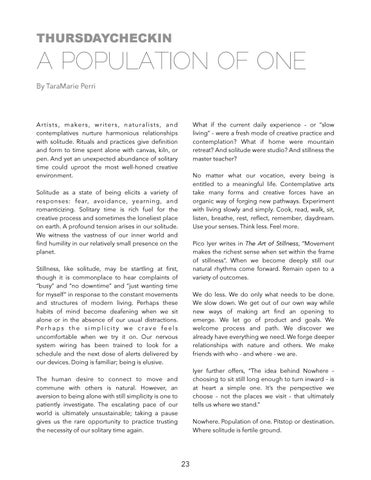THURSDAYCHECKIN
A POPULATION OF ONE By TaraMarie Perri
A r t i s t s , m a ke r s , w r i t e r s , n a t u r a l i s t s , a n d contemplatives nurture harmonious relationships with solitude. Rituals and practices give definition and form to time spent alone with canvas, kiln, or pen. And yet an unexpected abundance of solitary time could uproot the most well-honed creative environment.
What if the current daily experience – or “slow living” – were a fresh mode of creative practice and contemplation? What if home were mountain retreat? And solitude were studio? And stillness the master teacher? No matter what our vocation, every being is entitled to a meaningful life. Contemplative arts take many forms and creative forces have an organic way of forging new pathways. Experiment with living slowly and simply. Cook, read, walk, sit, listen, breathe, rest, reflect, remember, daydream. Use your senses. Think less. Feel more.
Solitude as a state of being elicits a variety of responses: fear, avoidance, yearning, and romanticizing. Solitary time is rich fuel for the creative process and sometimes the loneliest place on earth. A profound tension arises in our solitude. We witness the vastness of our inner world and find humility in our relatively small presence on the planet.
Pico Iyer writes in The Art of Stillness, “Movement makes the richest sense when set within the frame of stillness”. When we become deeply still our natural rhythms come forward. Remain open to a variety of outcomes.
Stillness, like solitude, may be startling at first, though it is commonplace to hear complaints of “busy” and “no downtime” and “just wanting time for myself” in response to the constant movements and structures of modern living. Perhaps these habits of mind become deafening when we sit alone or in the absence of our usual distractions. Pe r h a p s t h e s i m p l i c i t y w e c r a v e f e e l s uncomfortable when we try it on. Our nervous system wiring has been trained to look for a schedule and the next dose of alerts delivered by our devices. Doing is familiar; being is elusive.
We do less. We do only what needs to be done. We slow down. We get out of our own way while new ways of making art find an opening to emerge. We let go of product and goals. We welcome process and path. We discover we already have everything we need. We forge deeper relationships with nature and others. We make friends with who - and where - we are. Iyer further offers, “The idea behind Nowhere – choosing to sit still long enough to turn inward – is at heart a simple one. It’s the perspective we choose – not the places we visit – that ultimately tells us where we stand.”
The human desire to connect to move and commune with others is natural. However, an aversion to being alone with still simplicity is one to patiently investigate. The escalating pace of our world is ultimately unsustainable; taking a pause gives us the rare opportunity to practice trusting the necessity of our solitary time again.
Nowhere. Population of one. Pitstop or destination. Where solitude is fertile ground.
23





